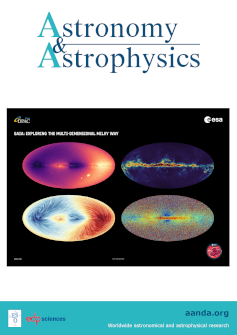北十字星快速射电暴项目
IF 5.8
2区 物理与天体物理
Q1 ASTRONOMY & ASTROPHYSICS
引用次数: 0
摘要
上下文。人们对磁星的射电发射知之甚少,观测特征也很差,特别是对单脉冲和零星事件。对这种类型的射电发射的兴趣已经被2020年从被命名为SGR J1935+2154的银河系磁星探测到的极其明亮的毫秒射电信号所提振,该信号几乎与一个典型的磁星短x射线爆发同时发生。到目前为止,这个事件仍然是银河系射电脉冲,它最容易让人想起快速射电暴,而且它是唯一一个与已知祖先有良好联系的事件。我们的目标是通过高灵敏度射电望远镜的密集监测来限制来自磁星的脉冲射电事件的速率。我们利用北十字星凌日射电望远镜(位于意大利的美第奇纳)对七颗银河系磁星(外加一颗候选星)进行了长期观测,寻找短时间尺度和分散的射电脉冲。我们在~ 560小时的观测中没有检测到,将能量≥1028 erg的事件率的上限设定为< 52 yr−1的95%置信水平,这与文献中的限制一致。此外,在一些关于磁星的性质和能量行为的假设下,我们发现我们的上限指向这样一个事实,即观测到的所有快速射电暴都不能用磁星发射的射电暴来解释。本文章由计算机程序翻译,如有差异,请以英文原文为准。
The Northern Cross Fast Radio Burst project
Context. The radio emission from magnetars is poorly understood and poorly characterized observationally, particularly for what concerns single pulses and sporadic events. Interest in this type of radio emission has been boosted by the detection of an extremely bright millisecond radio signal from the Galactic magnetar designated as SGR J1935+2154 in 2020, which occurred almost simultaneously with a typical magnetar short burst of X-rays. As of now, this event remains the Galactic radio pulse that is the most reminiscent of fast radio bursts, and it is the only one that has a sound association with a known progenitor.Aims. We aim to constrain the rate of impulsive radio events from magnetars by means of intensive monitoring using a high-sensitivity radio telescope.Methods. We performed a long-term campaign on seven Galactic magnetars (plus one candidate) using the Northern Cross transit radio telescope (in Medicina, Italy), searching for short timescales and dispersed radio pulses.Results. We obtained no detections in ∼560 hours of observation, setting an upper limit at a 95% confidence level of < 52 yr−1 on the rate of events with energy ≳1028 erg, which is consistent with limits in the literature. Furthermore, under some assumptions regarding the properties and energetic behavior of magnetars, we find that our upper limits point toward the fact that the entire population of observed fast radio bursts cannot be explained by radio bursts emitted by magnetars.
求助全文
通过发布文献求助,成功后即可免费获取论文全文。
去求助
来源期刊

Astronomy & Astrophysics
地学天文-天文与天体物理
CiteScore
10.20
自引率
27.70%
发文量
2105
审稿时长
1-2 weeks
期刊介绍:
Astronomy & Astrophysics is an international Journal that publishes papers on all aspects of astronomy and astrophysics (theoretical, observational, and instrumental) independently of the techniques used to obtain the results.
 求助内容:
求助内容: 应助结果提醒方式:
应助结果提醒方式:


